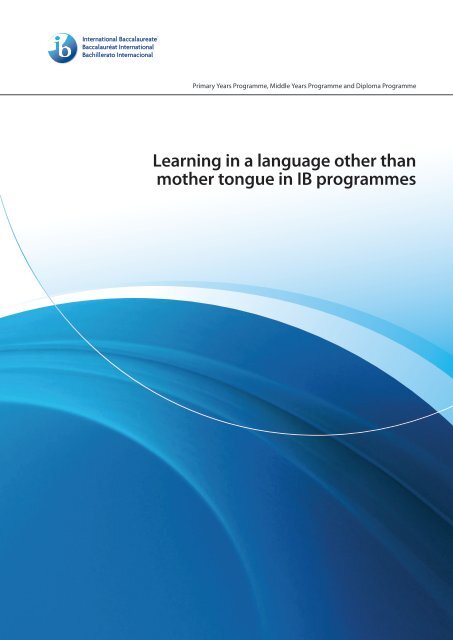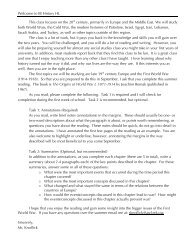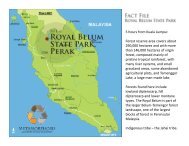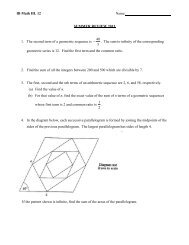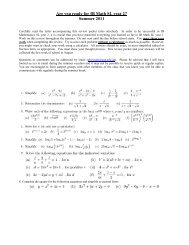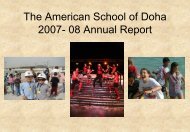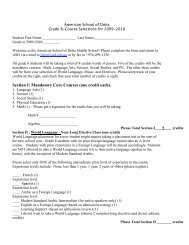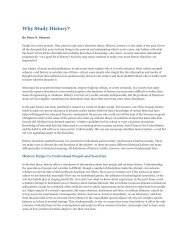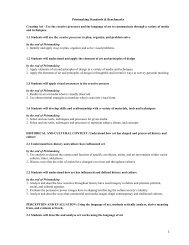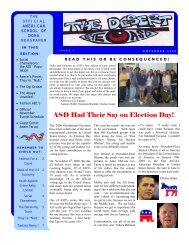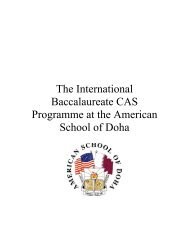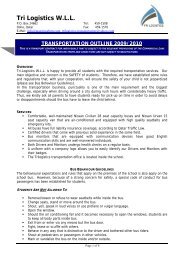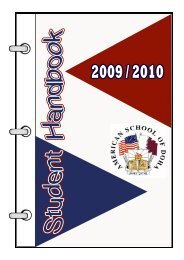Learning in a language other than mother tongue in IB programmes
Learning in a language other than mother tongue in IB programmes
Learning in a language other than mother tongue in IB programmes
You also want an ePaper? Increase the reach of your titles
YUMPU automatically turns print PDFs into web optimized ePapers that Google loves.
Primary Years Programme, Middle Years Programme and Diploma Programme<br />
<strong>Learn<strong>in</strong>g</strong> <strong>in</strong> a <strong>language</strong> <strong>other</strong> <strong>than</strong><br />
m<strong>other</strong> <strong>tongue</strong> <strong>in</strong> <strong>IB</strong> <strong>programmes</strong>
Primary Years Programme, Middle Years Programme and Diploma Programme<br />
<strong>Learn<strong>in</strong>g</strong> <strong>in</strong> a <strong>language</strong> <strong>other</strong> <strong>than</strong><br />
m<strong>other</strong> <strong>tongue</strong> <strong>in</strong> <strong>IB</strong> <strong>programmes</strong>
Primary Years Programme, Middle Years Programme<br />
and Diploma Programme<br />
<strong>Learn<strong>in</strong>g</strong> <strong>in</strong> a <strong>language</strong> <strong>other</strong> <strong>than</strong> m<strong>other</strong> <strong>tongue</strong><br />
<strong>in</strong> <strong>IB</strong> <strong>programmes</strong><br />
Published April 2008<br />
International Baccalaureate<br />
Peterson House, Malthouse Avenue, Cardiff Gate<br />
Cardiff, Wales GB CF23 8GL<br />
United K<strong>in</strong>gdom<br />
Phone: +44 29 2054 7777<br />
Fax: +44 29 2054 7778<br />
Website: http://www.ibo.org<br />
© International Baccalaureate Organization 2008<br />
The International Baccalaureate (<strong>IB</strong>) offers three high quality and challeng<strong>in</strong>g<br />
educational <strong>programmes</strong> for a worldwide community of schools, aim<strong>in</strong>g to create a<br />
better, more peaceful world.<br />
The <strong>IB</strong> is grateful for permission to reproduce and/or translate any copyright material<br />
used <strong>in</strong> this publication. Acknowledgments are <strong>in</strong>cluded, where appropriate, and,<br />
if notified, the <strong>IB</strong> will be pleased to rectify any errors or omissions at the earliest<br />
opportunity.<br />
All rights reserved. No part of this publication may be reproduced, stored <strong>in</strong> a retrieval<br />
system, or transmitted, <strong>in</strong> any form or by any means, without the prior written<br />
permission of the <strong>IB</strong>, or as expressly permitted by law or by the <strong>IB</strong>’s own rules and<br />
policy. See http://www.ibo.org/copyright.<br />
<strong>IB</strong> merchandise and publications can be purchased through the <strong>IB</strong> store at<br />
http://store.ibo.org. General order<strong>in</strong>g queries should be directed to the sales and<br />
market<strong>in</strong>g department <strong>in</strong> Cardiff.<br />
Phone: +44 29 2054 7746<br />
Fax: +44 29 2054 7779<br />
Email: sales@ibo.org
<strong>IB</strong> mission statement<br />
The International Baccalaureate aims to develop <strong>in</strong>quir<strong>in</strong>g, knowledgeable and car<strong>in</strong>g young people who help to<br />
create a better and more peaceful world through <strong>in</strong>tercultural understand<strong>in</strong>g and respect.<br />
To this end the organization works with schools, governments and <strong>in</strong>ternational organizations to develop<br />
challeng<strong>in</strong>g <strong>programmes</strong> of <strong>in</strong>ternational education and rigorous assessment.<br />
These <strong>programmes</strong> encourage students across the world to become active, compassionate and lifelong learners<br />
who understand that <strong>other</strong> people, with their differences, can also be right.<br />
<strong>IB</strong> learner profile<br />
The aim of all <strong>IB</strong> <strong>programmes</strong> is to develop <strong>in</strong>ternationally m<strong>in</strong>ded people who, recogniz<strong>in</strong>g their common<br />
humanity and shared guardianship of the planet, help to create a better and more peaceful world.<br />
<strong>IB</strong> learners strive to be:<br />
Inquirers<br />
Knowledgeable<br />
Th<strong>in</strong>kers<br />
Communicators<br />
Pr<strong>in</strong>cipled<br />
Open-m<strong>in</strong>ded<br />
Car<strong>in</strong>g<br />
Risk-takers<br />
Balanced<br />
Reflective<br />
They develop their natural curiosity. They acquire the skills necessary to conduct <strong>in</strong>quiry<br />
and research and show <strong>in</strong>dependence <strong>in</strong> learn<strong>in</strong>g. They actively enjoy learn<strong>in</strong>g and this<br />
love of learn<strong>in</strong>g will be susta<strong>in</strong>ed throughout their lives.<br />
They explore concepts, ideas and issues that have local and global significance. In so<br />
do<strong>in</strong>g, they acquire <strong>in</strong>-depth knowledge and develop understand<strong>in</strong>g across a broad and<br />
balanced range of discipl<strong>in</strong>es.<br />
They exercise <strong>in</strong>itiative <strong>in</strong> apply<strong>in</strong>g th<strong>in</strong>k<strong>in</strong>g skills critically and creatively to recognize and<br />
approach complex problems, and make reasoned, ethical decisions.<br />
They understand and express ideas and <strong>in</strong>formation confidently and creatively <strong>in</strong> more<br />
<strong>than</strong> one <strong>language</strong> and <strong>in</strong> a variety of modes of communication. They work effectively<br />
and will<strong>in</strong>gly <strong>in</strong> collaboration with <strong>other</strong>s.<br />
They act with <strong>in</strong>tegrity and honesty, with a strong sense of fairness, justice and respect<br />
for the dignity of the <strong>in</strong>dividual, groups and communities. They take responsibility for<br />
their own actions and the consequences that accompany them.<br />
They understand and appreciate their own cultures and personal histories, and are open<br />
to the perspectives, values and traditions of <strong>other</strong> <strong>in</strong>dividuals and communities. They are<br />
accustomed to seek<strong>in</strong>g and evaluat<strong>in</strong>g a range of po<strong>in</strong>ts of view, and are will<strong>in</strong>g to grow<br />
from the experience.<br />
They show empathy, compassion and respect towards the needs and feel<strong>in</strong>gs of <strong>other</strong>s.<br />
They have a personal commitment to service, and act to make a positive difference to the<br />
lives of <strong>other</strong>s and to the environment.<br />
They approach unfamiliar situations and uncerta<strong>in</strong>ty with courage and forethought, and<br />
have the <strong>in</strong>dependence of spirit to explore new roles, ideas and strategies. They are brave<br />
and articulate <strong>in</strong> defend<strong>in</strong>g their beliefs.<br />
They understand the importance of <strong>in</strong>tellectual, physical and emotional balance to<br />
achieve personal well-be<strong>in</strong>g for themselves and <strong>other</strong>s.<br />
They give thoughtful consideration to their own learn<strong>in</strong>g and experience. They are able<br />
to assess and understand their strengths and limitations <strong>in</strong> order to support their learn<strong>in</strong>g<br />
and personal development.<br />
© International Baccalaureate Organization 2007
Contents<br />
Introduction 1<br />
Preface 1<br />
Purpose of this document 2<br />
<strong>Learn<strong>in</strong>g</strong> <strong>in</strong> a <strong>language</strong> <strong>other</strong> <strong>than</strong> m<strong>other</strong> <strong>tongue</strong> 3<br />
Philosophical underp<strong>in</strong>n<strong>in</strong>gs 3<br />
A conceptual framework of <strong>language</strong> and learn<strong>in</strong>g 4<br />
<strong>Learn<strong>in</strong>g</strong> <strong>language</strong> 4<br />
<strong>Learn<strong>in</strong>g</strong> through <strong>language</strong> 5<br />
<strong>Learn<strong>in</strong>g</strong> about <strong>language</strong> 5<br />
Conditions for learn<strong>in</strong>g 6<br />
Activate prior understand<strong>in</strong>g and build background knowledge 6<br />
Scaffold mean<strong>in</strong>g 7<br />
Extend <strong>language</strong> 8<br />
Affirm identity 8<br />
General implications for practice 9<br />
Appendices 10<br />
References 10<br />
Suggested further read<strong>in</strong>gs 11<br />
<strong>Learn<strong>in</strong>g</strong> <strong>in</strong> a <strong>language</strong> <strong>other</strong> <strong>than</strong> m<strong>other</strong> <strong>tongue</strong> <strong>in</strong> <strong>IB</strong> <strong>programmes</strong>
Introduction<br />
Preface<br />
Language stands at the center of the many <strong>in</strong>terdependent cognitive, affective,<br />
and social factors that shape learn<strong>in</strong>g.<br />
Corson (1999)<br />
Language is <strong>in</strong>tegral to explor<strong>in</strong>g and susta<strong>in</strong><strong>in</strong>g personal development, cultural identity and <strong>in</strong>tercultural<br />
understand<strong>in</strong>g. As well as be<strong>in</strong>g the major medium of social communication, it is tightly l<strong>in</strong>ked to cognitive<br />
growth because it is the process by which mean<strong>in</strong>g and knowledge is negotiated and constructed. It is<br />
the ma<strong>in</strong> tool for build<strong>in</strong>g our knowledge of the universe and our place <strong>in</strong> it. Language then, is central to<br />
learn<strong>in</strong>g, as well as to literacy, and is thus closely related to success <strong>in</strong> school.<br />
As a result of the global population’s <strong>in</strong>creas<strong>in</strong>g mobility, many learners <strong>in</strong> schools are construct<strong>in</strong>g<br />
knowledge <strong>in</strong> a <strong>language</strong> that is not their m<strong>other</strong> <strong>tongue</strong>. A <strong>language</strong> profile of any one of these learners<br />
may demonstrate two or more <strong>language</strong>s <strong>in</strong> his or her learn<strong>in</strong>g cont<strong>in</strong>uum. This situation has created new<br />
challenges for learners, teachers and schools who, <strong>in</strong> the past, have assumed a common monol<strong>in</strong>gual,<br />
monocultural sett<strong>in</strong>g. Various responses to these challenges, together with prolific research, have resulted <strong>in</strong><br />
a wealth of expertise on good practices that nurture the valuable diversity of multil<strong>in</strong>gual and multicultural<br />
classrooms to its full potential <strong>in</strong> develop<strong>in</strong>g <strong>in</strong>ternationally m<strong>in</strong>ded people. The <strong>IB</strong> is committed to shar<strong>in</strong>g<br />
this expertise with all stakeholders.<br />
Along with the research relat<strong>in</strong>g to <strong>language</strong> and learn<strong>in</strong>g, there has been an expansion of jargon.<br />
Terms for learners such as English as a second <strong>language</strong> (ESL), English as an additional <strong>language</strong> (EAL),<br />
second <strong>language</strong> learn<strong>in</strong>g (SLL) and English speakers of <strong>other</strong> <strong>language</strong>s (ESOL) carry with them differ<strong>in</strong>g<br />
connotations depend<strong>in</strong>g on cultural context. The term of reference <strong>in</strong> this document will be “learners who<br />
are learn<strong>in</strong>g <strong>in</strong> a <strong>language</strong> <strong>other</strong> <strong>than</strong> their m<strong>other</strong> <strong>tongue</strong>”. The term m<strong>other</strong> <strong>tongue</strong> is used <strong>in</strong> the<br />
research literature <strong>in</strong> various ways. It may denote the <strong>language</strong> learned first; the <strong>language</strong> identified with<br />
as a “native” speaker; the <strong>language</strong> known best; the <strong>language</strong> used most. When used <strong>in</strong> this document, it<br />
<strong>in</strong>cludes all those mean<strong>in</strong>gs.<br />
<strong>Learn<strong>in</strong>g</strong> <strong>in</strong> a <strong>language</strong> <strong>other</strong> <strong>than</strong> m<strong>other</strong> <strong>tongue</strong> <strong>in</strong> <strong>IB</strong> <strong>programmes</strong><br />
1
Introduction<br />
Purpose of this document<br />
Many learners <strong>in</strong> <strong>IB</strong> <strong>programmes</strong> have rich and complex multil<strong>in</strong>gual backgrounds. This means a large<br />
number of learners must access the majority of an <strong>IB</strong> programme curriculum <strong>in</strong> a <strong>language</strong> <strong>other</strong> <strong>than</strong> their<br />
m<strong>other</strong> <strong>tongue</strong>. A thorough understand<strong>in</strong>g of how this situation impacts on learn<strong>in</strong>g is essential if schools<br />
are to ensure that the value of the learner diversity is not lost, that there is equal access to the curriculum<br />
for all learners and that the standards of conditions and practices <strong>in</strong> place foster a successful teach<strong>in</strong>g and<br />
learn<strong>in</strong>g environment for everyone.<br />
This document therefore provides a conceptual framework of <strong>language</strong> and learn<strong>in</strong>g that is applicable to<br />
all <strong>IB</strong> learners. The particular implications for schools <strong>in</strong> guarantee<strong>in</strong>g equal access to an <strong>IB</strong> programme for<br />
learners who are learn<strong>in</strong>g <strong>in</strong> a <strong>language</strong> <strong>other</strong> <strong>than</strong> their m<strong>other</strong> <strong>tongue</strong> are also described.<br />
2<br />
<strong>Learn<strong>in</strong>g</strong> <strong>in</strong> a <strong>language</strong> <strong>other</strong> <strong>than</strong> m<strong>other</strong> <strong>tongue</strong> <strong>in</strong> <strong>IB</strong> <strong>programmes</strong>
<strong>Learn<strong>in</strong>g</strong> <strong>in</strong> a <strong>language</strong> <strong>other</strong> <strong>than</strong> m<strong>other</strong> <strong>tongue</strong><br />
Philosophical underp<strong>in</strong>n<strong>in</strong>gs<br />
The <strong>IB</strong> offers three high quality and challeng<strong>in</strong>g educational <strong>programmes</strong> for a worldwide community of<br />
schools, aim<strong>in</strong>g to create a better, more peaceful world through <strong>in</strong>tercultural understand<strong>in</strong>g and respect.<br />
Crucial for the success of the <strong>programmes</strong> is a rich development of <strong>language</strong> and literacy for all learners. The<br />
ability to communicate <strong>in</strong> a variety of modes <strong>in</strong> more <strong>than</strong> one <strong>language</strong> is essential to the concept of an<br />
<strong>in</strong>ternational education that promotes <strong>in</strong>tercultural understand<strong>in</strong>g. Consequently, this requirement is built<br />
<strong>in</strong>to the standards and practices of all three <strong>IB</strong> <strong>programmes</strong> as well as the <strong>IB</strong> learner profile. Recogniz<strong>in</strong>g that<br />
the <strong>language</strong> profiles of <strong>IB</strong> learners are diverse, and that sometimes one <strong>language</strong> may be more dom<strong>in</strong>ant<br />
<strong>than</strong> an<strong>other</strong> <strong>in</strong> the same <strong>in</strong>dividual, <strong>IB</strong> <strong>programmes</strong> offer a variety of opportunities for learn<strong>in</strong>g more <strong>than</strong><br />
one <strong>language</strong>.<br />
Learners access<strong>in</strong>g an <strong>IB</strong> programme <strong>in</strong> a <strong>language</strong> <strong>other</strong> <strong>than</strong> their m<strong>other</strong> <strong>tongue</strong> are potentially able<br />
to become balanced bil<strong>in</strong>guals who are highly proficient, literate and knowledgeable <strong>in</strong> two or more<br />
<strong>language</strong>s. The <strong>IB</strong> recognizes this valuable potential and the need for guidel<strong>in</strong>es for schools on the best<br />
practices for its nurture. Therefore, this document provides a framework for understand<strong>in</strong>g <strong>language</strong> and<br />
learn<strong>in</strong>g, and how it <strong>in</strong>forms good practice <strong>in</strong> <strong>IB</strong> <strong>programmes</strong>.<br />
<strong>Learn<strong>in</strong>g</strong> <strong>in</strong> a <strong>language</strong> <strong>other</strong> <strong>than</strong> m<strong>other</strong> <strong>tongue</strong> <strong>in</strong> <strong>IB</strong> <strong>programmes</strong><br />
3
<strong>Learn<strong>in</strong>g</strong> <strong>in</strong> a <strong>language</strong> <strong>other</strong> <strong>than</strong> m<strong>other</strong> <strong>tongue</strong><br />
A conceptual framework of <strong>language</strong> and learn<strong>in</strong>g<br />
Almost all education is <strong>language</strong> education.<br />
Postman (1996)<br />
Language learn<strong>in</strong>g <strong>in</strong> school is not a separate discipl<strong>in</strong>e isolated from all <strong>other</strong> learn<strong>in</strong>g (except when studied<br />
as l<strong>in</strong>guistics). As well as be<strong>in</strong>g part of social and personal development, <strong>language</strong> learn<strong>in</strong>g <strong>in</strong> school is<br />
crucial for academic cognitive growth and the construction of knowledge. The <strong>language</strong> of academic<br />
discourses and the mean<strong>in</strong>g and the knowledge content of any one discipl<strong>in</strong>e are closely <strong>in</strong>terwoven. For<br />
example, the discourse of mathematics is dist<strong>in</strong>ct from the discourse of history and, <strong>in</strong> each case, is <strong>in</strong>tegral<br />
to construct<strong>in</strong>g mean<strong>in</strong>g. Similarly, the discourses of <strong>in</strong>terpersonal communications vary depend<strong>in</strong>g on<br />
purpose. The <strong>language</strong> of a compla<strong>in</strong>t will be different from that of a wedd<strong>in</strong>g <strong>in</strong>vitation. The features of<br />
different discourses have been identified and are described <strong>in</strong> l<strong>in</strong>guistic genre theory.<br />
A l<strong>in</strong>guistic genre is a particular text type created by a specific communicative situation. Examples of some<br />
common genres used <strong>in</strong> school are recount, narrative, report, explanation, argument and discussion. As<br />
learners <strong>in</strong> schools build knowledge <strong>in</strong> and across discipl<strong>in</strong>es, they move along a cont<strong>in</strong>uum of <strong>language</strong><br />
and learn<strong>in</strong>g that <strong>in</strong>cludes an ability to use and understand a range of academic l<strong>in</strong>guistic genres.<br />
A conceptual understand<strong>in</strong>g of the <strong>language</strong> and learn<strong>in</strong>g cont<strong>in</strong>uum is critical <strong>in</strong> determ<strong>in</strong><strong>in</strong>g what should<br />
be the focus <strong>in</strong> the processes of <strong>language</strong> teach<strong>in</strong>g and learn<strong>in</strong>g. It will <strong>in</strong>form the stag<strong>in</strong>g of these processes<br />
<strong>in</strong> the curriculum as well as the k<strong>in</strong>ds of materials used and developed for learn<strong>in</strong>g.<br />
Halliday (1985) expresses some of the complexity of the relationship between <strong>language</strong> and learn<strong>in</strong>g<br />
when he talks about “learn<strong>in</strong>g <strong>language</strong>, learn<strong>in</strong>g through <strong>language</strong> and learn<strong>in</strong>g about <strong>language</strong>”.<br />
Three aspects of <strong>language</strong> and learn<strong>in</strong>g development are identified, although it must be emphasized that<br />
<strong>language</strong> development is a process of construct<strong>in</strong>g mean<strong>in</strong>g <strong>in</strong> which all three aspects, learn<strong>in</strong>g <strong>language</strong>,<br />
learn<strong>in</strong>g through <strong>language</strong> and learn<strong>in</strong>g about <strong>language</strong>, are operat<strong>in</strong>g at any one time. A separate<br />
exam<strong>in</strong>ation of each, however, can provide a fuller understand<strong>in</strong>g of what is <strong>in</strong>volved.<br />
<strong>Learn<strong>in</strong>g</strong> <strong>language</strong><br />
In the early stages of life when a child is first learn<strong>in</strong>g to communicate <strong>in</strong> a m<strong>other</strong> <strong>tongue</strong>, he or she is<br />
learn<strong>in</strong>g to use <strong>language</strong> symbolically <strong>in</strong> order to construct mean<strong>in</strong>g and to <strong>in</strong>teract. In a safe, secure and<br />
nurtur<strong>in</strong>g environment, rich <strong>in</strong> stimulat<strong>in</strong>g experiences, the child exchanges signals with <strong>other</strong>s and learns<br />
to recognize, articulate and encode sounds, rhythms and <strong>in</strong>tonations while associat<strong>in</strong>g them with mean<strong>in</strong>gs<br />
or concepts. He or she may associate the sound “bo”, for example, with a ball and learn that by utter<strong>in</strong>g the<br />
word the m<strong>other</strong> is likely to respond <strong>in</strong> some way; perhaps by roll<strong>in</strong>g it for him. The child is build<strong>in</strong>g up a<br />
resource for mean<strong>in</strong>g.<br />
The child is also develop<strong>in</strong>g what Cumm<strong>in</strong>s (1979) calls basic <strong>in</strong>terpersonal communicative skills or BICS.<br />
This is the dimension of <strong>language</strong> that will enable a child to <strong>in</strong>teract socially with teachers and peers when<br />
he or she beg<strong>in</strong>s school. The <strong>language</strong> of such communication is supported by contextual cues as well as<br />
by gestures and facial expressions. Learners who already have communicative skills <strong>in</strong> a m<strong>other</strong> <strong>tongue</strong> may<br />
become functional <strong>in</strong> social communication <strong>in</strong> an<strong>other</strong> <strong>language</strong> with<strong>in</strong> two years because of the transfer of<br />
understand<strong>in</strong>g already <strong>in</strong> place.<br />
4<br />
<strong>Learn<strong>in</strong>g</strong> <strong>in</strong> a <strong>language</strong> <strong>other</strong> <strong>than</strong> m<strong>other</strong> <strong>tongue</strong> <strong>in</strong> <strong>IB</strong> <strong>programmes</strong>
A conceptual framework of <strong>language</strong> and learn<strong>in</strong>g<br />
As well as oral skills, the young child develops the early literacy skills of recogniz<strong>in</strong>g and manipulat<strong>in</strong>g<br />
symbols for decod<strong>in</strong>g and encod<strong>in</strong>g written texts <strong>in</strong> order to read and write. This <strong>in</strong>cludes learn<strong>in</strong>g to form<br />
the shapes of the letters or characters of a writ<strong>in</strong>g system and their phonetic associations. Learners who<br />
have basic literacy skills <strong>in</strong> their m<strong>other</strong> <strong>tongue</strong> are able to transfer some of these understand<strong>in</strong>gs and<br />
concepts when learn<strong>in</strong>g an<strong>other</strong> <strong>language</strong>.<br />
<strong>Learn<strong>in</strong>g</strong> <strong>language</strong> is ongo<strong>in</strong>g and is further fostered through read<strong>in</strong>g.<br />
<strong>Learn<strong>in</strong>g</strong> through <strong>language</strong><br />
At some po<strong>in</strong>t a child has enough <strong>language</strong> so that <strong>in</strong> addition to it be<strong>in</strong>g a communicative tool, it is also<br />
a flexible resource for further learn<strong>in</strong>g and cognitive growth. Language itself, rather <strong>than</strong> direct concrete<br />
experience, can be used to negotiate new mean<strong>in</strong>gs and construct knowledge about the world. Literacy<br />
becomes <strong>in</strong>creas<strong>in</strong>gly important <strong>in</strong> do<strong>in</strong>g this as more abstract learn<strong>in</strong>g takes place through dense academic<br />
texts <strong>in</strong> school. The ability to access the <strong>language</strong> of these texts is referred to as a cognitive academic<br />
<strong>language</strong> proficiency or CALP by Cumm<strong>in</strong>s (1979).<br />
For some learners <strong>in</strong> <strong>IB</strong> <strong>programmes</strong>, the <strong>language</strong> <strong>in</strong> which they are learn<strong>in</strong>g and develop<strong>in</strong>g their CALP is<br />
not the same as their m<strong>other</strong> <strong>tongue</strong> and this has implications for school organization as well as classroom<br />
practice. Depend<strong>in</strong>g on age and experience, for example, some learners may have a wealth of knowledge<br />
<strong>in</strong> a <strong>language</strong> <strong>other</strong> <strong>than</strong> that of the classroom. However, it can take up to seven years for learners who are<br />
us<strong>in</strong>g a <strong>language</strong> <strong>other</strong> <strong>than</strong> their m<strong>other</strong> <strong>tongue</strong> to atta<strong>in</strong> the same levels <strong>in</strong> academic <strong>language</strong> proficiency<br />
as those expected for learners learn<strong>in</strong>g <strong>in</strong> a m<strong>other</strong> <strong>tongue</strong>.<br />
<strong>Learn<strong>in</strong>g</strong> about <strong>language</strong><br />
Understand<strong>in</strong>g the relationship of <strong>language</strong> and mean<strong>in</strong>g and how <strong>language</strong> works <strong>in</strong> the construction<br />
of knowledge empowers the <strong>language</strong> user. A learner <strong>in</strong> an <strong>IB</strong> programme who has a critical <strong>language</strong><br />
awareness will be able to make choices about <strong>language</strong> use accord<strong>in</strong>g to his or her purpose and audience, as<br />
well as ga<strong>in</strong> <strong>in</strong>sight <strong>in</strong>to the <strong>language</strong> choices of <strong>other</strong>s. For example, an understand<strong>in</strong>g of various l<strong>in</strong>guistic<br />
genres means that a writer can choose the most appropriate genre for the task.<br />
Some learners who are learn<strong>in</strong>g <strong>in</strong> their m<strong>other</strong> <strong>tongue</strong> may have an <strong>in</strong>tuitive unconscious sense of how the<br />
<strong>language</strong> works and have a full range of choices and l<strong>in</strong>guistic genres available to them. Learners who are<br />
us<strong>in</strong>g a <strong>language</strong> <strong>other</strong> <strong>than</strong> their m<strong>other</strong> <strong>tongue</strong> to access an <strong>IB</strong> programme cannot always be assumed to<br />
have this awareness, which therefore needs to be explicitly taught <strong>in</strong> such circumstances.<br />
<strong>Learn<strong>in</strong>g</strong> <strong>in</strong> a <strong>language</strong> <strong>other</strong> <strong>than</strong> m<strong>other</strong> <strong>tongue</strong> <strong>in</strong> <strong>IB</strong> <strong>programmes</strong><br />
5
<strong>Learn<strong>in</strong>g</strong> <strong>in</strong> a <strong>language</strong> <strong>other</strong> <strong>than</strong> m<strong>other</strong> <strong>tongue</strong><br />
Conditions for learn<strong>in</strong>g<br />
A threshold level of proficiency <strong>in</strong> cognitive academic <strong>language</strong> is essential for the learner participation and<br />
engagement that is necessary for subsequent success <strong>in</strong> an <strong>IB</strong> programme.<br />
Cumm<strong>in</strong>s (2007) proposes that the four dimensions of teach<strong>in</strong>g that are particularly important <strong>in</strong> ensur<strong>in</strong>g<br />
learner participation and promot<strong>in</strong>g engagement are:<br />
• to activate prior understand<strong>in</strong>g and build background knowledge<br />
• to scaffold mean<strong>in</strong>g<br />
• to extend <strong>language</strong><br />
• to affirm identity.<br />
Activate prior understand<strong>in</strong>g and build background<br />
knowledge<br />
New learn<strong>in</strong>g and understand<strong>in</strong>g is constructed on previous experiences and conceptual understand<strong>in</strong>gs <strong>in</strong><br />
a developmental cont<strong>in</strong>uum. Krashen (2002) stresses the importance of comprehensible <strong>in</strong>put for learn<strong>in</strong>g<br />
to take place. If new <strong>in</strong>formation cannot be understood, it cannot be l<strong>in</strong>ked to prior knowledge and become<br />
part of deep learn<strong>in</strong>g. The psychologist Vygotsky (1978) describes a zone of proximal development (ZPD)<br />
with<strong>in</strong> which new learn<strong>in</strong>g can take place if there is support. The ZPD lies beyond the zone of prior know<strong>in</strong>g,<br />
which is where a learner can work <strong>in</strong>dependently without support. Anyth<strong>in</strong>g outside the ZPD is not yet able<br />
to be learned.<br />
Zone of proximal development<br />
Prior<br />
knowledge<br />
Figure 1: Zone of proximal development<br />
6<br />
<strong>Learn<strong>in</strong>g</strong> <strong>in</strong> a <strong>language</strong> <strong>other</strong> <strong>than</strong> m<strong>other</strong> <strong>tongue</strong> <strong>in</strong> <strong>IB</strong> <strong>programmes</strong>
Conditions for learn<strong>in</strong>g<br />
When plann<strong>in</strong>g the range of new learn<strong>in</strong>g that can take place <strong>in</strong> any <strong>in</strong>dividual, previous learn<strong>in</strong>g experiences<br />
or prior know<strong>in</strong>g must be taken <strong>in</strong>to consideration.<br />
It cannot be assumed that those learners who are learn<strong>in</strong>g <strong>in</strong> a <strong>language</strong> <strong>other</strong> <strong>than</strong> their m<strong>other</strong> <strong>tongue</strong> will<br />
necessarily all share the same previous learn<strong>in</strong>g and background knowledge. It may be, however, that these<br />
learners have a wealth of relevant background knowledge encoded <strong>in</strong> their m<strong>other</strong> <strong>tongue</strong> that can be<br />
activated as a base for further learn<strong>in</strong>g. However, the teacher may have to build up background knowledge<br />
<strong>in</strong> preparation for further learn<strong>in</strong>g.<br />
Therefore, teachers should:<br />
• explicitly activate learners’ prior understand<strong>in</strong>g us<strong>in</strong>g the m<strong>other</strong> <strong>tongue</strong> if appropriate<br />
• use their knowledge of learners’ prior understand<strong>in</strong>g to differentiate tasks and activities that will build<br />
up the further background knowledge necessary for new learn<strong>in</strong>g to occur<br />
• record <strong>in</strong>formation <strong>in</strong> learner profiles that will support plann<strong>in</strong>g for future differentiation<br />
• consider the time and strategies necessary for activat<strong>in</strong>g and build<strong>in</strong>g up background knowledge<br />
when plann<strong>in</strong>g a unit of work or lesson.<br />
Scaffold mean<strong>in</strong>g<br />
Teach<strong>in</strong>g methodology has identified a variety of specific ways <strong>in</strong> which teachers can scaffold new learn<strong>in</strong>g<br />
<strong>in</strong> the ZPD to help learners understand text.<br />
Scaffold<strong>in</strong>g is a temporary strategy that enables learners to accomplish a task that would <strong>other</strong>wise be<br />
impossible or much more difficult to accomplish. The use of a m<strong>other</strong> <strong>tongue</strong> to carry out research that<br />
would be impossible for the learner <strong>in</strong> an<strong>other</strong> <strong>language</strong> is an example of scaffold<strong>in</strong>g. Other scaffold<strong>in</strong>g<br />
strategies may provide a more concrete and less abstract context for understand<strong>in</strong>g. Examples of these are:<br />
• visual aids<br />
• graphic organizers<br />
• demonstrations<br />
• dramatization<br />
• small, structured collaborative groups<br />
• teacher <strong>language</strong>.<br />
<strong>Learn<strong>in</strong>g</strong> about <strong>language</strong> such as word roots and learn<strong>in</strong>g how l<strong>in</strong>guistic genres work <strong>in</strong> particular discourses<br />
are also valuable scaffold<strong>in</strong>g strategies that give learners access to a rich diversity of sophisticated texts.<br />
Scaffold<strong>in</strong>g should foster learners’ <strong>in</strong>creas<strong>in</strong>g <strong>in</strong>dependence <strong>in</strong> tak<strong>in</strong>g responsibility for develop<strong>in</strong>g strategies<br />
for their own learn<strong>in</strong>g, thus always extend<strong>in</strong>g the ZPD.<br />
<strong>Learn<strong>in</strong>g</strong> <strong>in</strong> a <strong>language</strong> <strong>other</strong> <strong>than</strong> m<strong>other</strong> <strong>tongue</strong> <strong>in</strong> <strong>IB</strong> <strong>programmes</strong><br />
7
Conditions for learn<strong>in</strong>g<br />
Extend <strong>language</strong><br />
As learners progress through the grades, they are required to read and write <strong>in</strong>creas<strong>in</strong>gly sophisticated texts<br />
<strong>in</strong> the content areas of the curriculum. The academic <strong>language</strong> of such texts reflects:<br />
• the complexity and abstraction of the concepts that learners are required to understand<br />
• the <strong>in</strong>creased density of low frequency and technical vocabulary, many of which come from Lat<strong>in</strong> and<br />
Greek sources (for example, photosynthesis, revolution)<br />
• <strong>in</strong>creas<strong>in</strong>gly sophisticated grammatical constructions (for example, the passive voice).<br />
Teachers can help learners extend their <strong>language</strong> and read<strong>in</strong>g by comb<strong>in</strong><strong>in</strong>g high expectations with<br />
numerous opportunities for learner-centred practice and <strong>in</strong>teraction with cognitively rich materials and<br />
experiences. Learners who read extensively both <strong>in</strong>side and outside an <strong>IB</strong> programme have far greater<br />
opportunities to extend their academic <strong>language</strong> and concepts <strong>than</strong> those whose read<strong>in</strong>g is limited.<br />
Opportunities for enjoy<strong>in</strong>g read<strong>in</strong>g are important. Equally important are opportunities for practis<strong>in</strong>g writ<strong>in</strong>g<br />
<strong>in</strong> a wide range of genres.<br />
Affirm identity<br />
Language is <strong>in</strong>tegral to identity, which <strong>in</strong> turn determ<strong>in</strong>es how a person will act. A m<strong>other</strong> <strong>tongue</strong> and<br />
any <strong>other</strong> <strong>language</strong>s used <strong>in</strong> construct<strong>in</strong>g mean<strong>in</strong>g are <strong>in</strong>timately connected to a person’s relationship<br />
with the world and how they come to feel about that world. Social and emotional conditions for learn<strong>in</strong>g<br />
that value all <strong>language</strong>s and cultures and affirm the identity of each learner promote self-esteem and<br />
additive bil<strong>in</strong>gualism (where an<strong>other</strong> <strong>language</strong> and culture does not replace that of the m<strong>other</strong> <strong>tongue</strong>).<br />
They encourage the qualities, attitudes and characteristics identified <strong>in</strong> the <strong>IB</strong> learner profile, promot<strong>in</strong>g<br />
responsible citizenship and <strong>in</strong>ternational-m<strong>in</strong>dedness. Conditions that do not affirm identity result <strong>in</strong> learners<br />
with poor self-esteem and subtractive bil<strong>in</strong>gualism (where an<strong>other</strong> <strong>language</strong> and culture demotes or<br />
replaces that of the m<strong>other</strong> <strong>tongue</strong>). Such learners will be unable to develop many of the qualities, attitudes<br />
and characteristics of the learner profile.<br />
The identity of each learner must therefore be affirmed. This can be done by:<br />
• promot<strong>in</strong>g a class and school environment that welcomes and embraces the diversity of cultures and<br />
perspectives<br />
• valu<strong>in</strong>g and us<strong>in</strong>g the diversity of cultures and perspectives to enhance learn<strong>in</strong>g<br />
• establish<strong>in</strong>g a m<strong>other</strong>-<strong>tongue</strong> programme for all learners<br />
• liais<strong>in</strong>g with parents to establish understand<strong>in</strong>g of how best to collaborate to achieve shared goals.<br />
8 <strong>Learn<strong>in</strong>g</strong> <strong>in</strong> a <strong>language</strong> <strong>other</strong> <strong>than</strong> m<strong>other</strong> <strong>tongue</strong> <strong>in</strong> <strong>IB</strong> <strong>programmes</strong>
<strong>Learn<strong>in</strong>g</strong> <strong>in</strong> a <strong>language</strong> <strong>other</strong> <strong>than</strong> m<strong>other</strong> <strong>tongue</strong><br />
General implications for practice<br />
Knowledge of the <strong>language</strong> and learn<strong>in</strong>g connection, and the particular significance of this for those<br />
learners who are not us<strong>in</strong>g their m<strong>other</strong> <strong>tongue</strong> to access an <strong>IB</strong> programme, leads to an understand<strong>in</strong>g<br />
of the conditions and practices that need to be <strong>in</strong> place <strong>in</strong> schools if these learners are to be successful.<br />
The demands on the school to provide these conditions and practices should be clearly articulated <strong>in</strong> a<br />
whole-school <strong>language</strong> policy. The <strong>IB</strong> provides assistance on how to do this <strong>in</strong> the document Guidel<strong>in</strong>es for<br />
develop<strong>in</strong>g a school <strong>language</strong> policy (April 2008).<br />
Although some of the essential conditions and practices for ensur<strong>in</strong>g that there is equity of access have<br />
already been described, there are <strong>other</strong>s that must be <strong>in</strong>cluded.<br />
S<strong>in</strong>ce proficiency <strong>in</strong> cognitive academic <strong>language</strong> is <strong>in</strong>separable from successful learn<strong>in</strong>g <strong>in</strong> school, it makes<br />
sense to th<strong>in</strong>k of all teachers as hav<strong>in</strong>g some role <strong>in</strong> develop<strong>in</strong>g this. In <strong>other</strong> words, all teachers are <strong>language</strong><br />
teachers. In order that all teachers are able to be effective <strong>in</strong> this, professional development, especially as it<br />
concerns those learners who are learn<strong>in</strong>g <strong>in</strong> a <strong>language</strong> <strong>other</strong> <strong>than</strong> their m<strong>other</strong> <strong>tongue</strong>, needs to be <strong>in</strong> place.<br />
Experts qualified <strong>in</strong> the field of l<strong>in</strong>guistics should be available <strong>in</strong> school to work not only with learners but<br />
also with teachers, librarians, coord<strong>in</strong>ators and adm<strong>in</strong>istrators to ensure all are appropriately tra<strong>in</strong>ed <strong>in</strong> the<br />
best practices for teach<strong>in</strong>g those learn<strong>in</strong>g <strong>in</strong> a <strong>language</strong> <strong>other</strong> <strong>than</strong> their m<strong>other</strong> <strong>tongue</strong>. This professional<br />
development of teachers has implications for timetabl<strong>in</strong>g and time allocation <strong>in</strong> schools.<br />
As already mentioned, learners learn<strong>in</strong>g <strong>in</strong> a <strong>language</strong> that is not their m<strong>other</strong> <strong>tongue</strong> may take up to seven<br />
years or longer to reach the same proficiency level <strong>in</strong> academic <strong>language</strong> as a person learn<strong>in</strong>g <strong>in</strong> a m<strong>other</strong><br />
<strong>tongue</strong>. An <strong>in</strong>formed consideration of this should be part of any school policy or decision that may impact<br />
on the success of these learners. This <strong>in</strong>cludes:<br />
• m<strong>other</strong>-<strong>tongue</strong> <strong>programmes</strong><br />
• admissions policies<br />
• assessment policies<br />
• short- and long-term curriculum plann<strong>in</strong>g<br />
• models of <strong>language</strong> support and <strong>programmes</strong><br />
• learner course choices<br />
• teacher professional development<br />
• host-<strong>language</strong> <strong>programmes</strong><br />
• teacher recruitment<br />
• liaison with parents.<br />
Plann<strong>in</strong>g for the success of learners who are access<strong>in</strong>g an <strong>IB</strong> programme <strong>in</strong> a <strong>language</strong> <strong>other</strong> <strong>than</strong> their<br />
m<strong>other</strong> <strong>tongue</strong> requires consideration of all the factors mentioned <strong>in</strong> this document.<br />
<strong>Learn<strong>in</strong>g</strong> <strong>in</strong> a <strong>language</strong> <strong>other</strong> <strong>than</strong> m<strong>other</strong> <strong>tongue</strong> <strong>in</strong> <strong>IB</strong> <strong>programmes</strong><br />
9
Appendices<br />
References<br />
Corson, D. 1999. Language Policy <strong>in</strong> Schools: A Resource for Teachers and Adm<strong>in</strong>istrators. Mahwah, New Jersey.<br />
Lawrence Erlbaum Associates.<br />
Cumm<strong>in</strong>s, J. 1979. “Cognitive/academic <strong>language</strong> proficiency, l<strong>in</strong>guistic <strong>in</strong>terdependence, the optimum age<br />
question and some <strong>other</strong> matters”. Work<strong>in</strong>g Papers on Bil<strong>in</strong>gualism. Number 19. Pp 121–129.<br />
Cumm<strong>in</strong>s, J. Unpublished <strong>in</strong>terview with Carol Inugai-Dixon on conditions for learn<strong>in</strong>g. Interview conducted<br />
on 4 March 2007.<br />
Halliday, M. 1985. Three Aspects of Children’s Language Development: <strong>Learn<strong>in</strong>g</strong> Language, <strong>Learn<strong>in</strong>g</strong> through<br />
Language, <strong>Learn<strong>in</strong>g</strong> about Language. Unpublished manuscript. Sydney, Australia. University of Sydney,<br />
Department of L<strong>in</strong>guistics.<br />
Krashen, S. 2002. Second Language Acquisition and Second Language <strong>Learn<strong>in</strong>g</strong>. Visited 1 May 2007. http://<br />
www.sdkrashen.com/SL_Acquisition_and_<strong>Learn<strong>in</strong>g</strong>.<br />
Postman, N. 1996. The End of Education: Redef<strong>in</strong><strong>in</strong>g the Value of Schools. New York. V<strong>in</strong>tage Books.<br />
Vygotsky, LS. 1978. M<strong>in</strong>d <strong>in</strong> Society: The Development of higher psychological processes. Cambridge,<br />
Massachusetts. Harvard University Press.<br />
10 <strong>Learn<strong>in</strong>g</strong> <strong>in</strong> a <strong>language</strong> <strong>other</strong> <strong>than</strong> m<strong>other</strong> <strong>tongue</strong> <strong>in</strong> <strong>IB</strong> <strong>programmes</strong>
Appendices<br />
Suggested further read<strong>in</strong>gs<br />
Books<br />
Baker, C. 2000. The Care and Education of Young Bil<strong>in</strong>guals. Clevedon, UK. Multil<strong>in</strong>gual Matters.<br />
Baker, C. 2006. Foundations of Bil<strong>in</strong>gual Education and Bil<strong>in</strong>gualism. 4th Edition. Clevedon, UK. Multil<strong>in</strong>gual<br />
Matters.<br />
Brisl<strong>in</strong>, R. 1993. Understand<strong>in</strong>g Culture’s Influence on Behaviour. Texas, Harcourt, Brace College Publishers.<br />
Brutt-Griffler, J. 2002. Bil<strong>in</strong>gual Education and Bil<strong>in</strong>gualism. Clevedon, UK. Multil<strong>in</strong>gual Matters.<br />
Brutt-Griffler, J. 2002. World English: A Study of its Development. Clevedon, UK. Multil<strong>in</strong>gual Matters.<br />
Byram, M and Grundy, P. 2003. Context and Culture <strong>in</strong> Language Teach<strong>in</strong>g and <strong>Learn<strong>in</strong>g</strong>. Clevedon, UK.<br />
Multil<strong>in</strong>gual Matters.<br />
Carder, M. 2007. Bil<strong>in</strong>gualism <strong>in</strong> International Schools. Clevedon, UK. Multil<strong>in</strong>gual Matters.<br />
Chamot, AU and O’Malley, JM. 1994. The CALLA Handbook: Implement<strong>in</strong>g the Cognitive Academic Language<br />
<strong>Learn<strong>in</strong>g</strong> Approach. Addison Wesley Publish<strong>in</strong>g Company.<br />
Cloud, N, Genesee, F and Hamayan, E. 2000. Dual Language Instruction. Boston, Massachusetts. He<strong>in</strong>le &<br />
He<strong>in</strong>le.<br />
Crystal, D. 2006. How Language Works: How Babies Babble, Words Change Mean<strong>in</strong>g and Languages Live or Die.<br />
Woodstock, New York. Overlook Press.<br />
Cumm<strong>in</strong>s, J. 2000. Language, Power and Pedagogy: Bil<strong>in</strong>gual Children <strong>in</strong> the Crossfire. Clevedon, UK. Multil<strong>in</strong>gual<br />
Matters.<br />
Cushner, K. 1990. “Cross-cultural psychology and the formal classroom”. In RW Brisl<strong>in</strong>’s (ed) Applied Cross-<br />
Cultural Psychology. Newbury Park, California. Sage.<br />
Doll, WE. 1993. A Post Modern Perspective on Curriculum. New York, New York. Teachers College Press.<br />
Gibson, F. 2006. Language Plann<strong>in</strong>g and Education. Ed<strong>in</strong>burgh, UK. Ed<strong>in</strong>burgh University Press.<br />
Gallagher, E. Forthcom<strong>in</strong>g. Many Languages, One Message: Equal Rights to the Curriculum. Clevedon, UK.<br />
Multil<strong>in</strong>gual Matters.<br />
Gibbons, P. 2002. Scaffold<strong>in</strong>g Language Scaffold<strong>in</strong>g <strong>Learn<strong>in</strong>g</strong>. Portsmouth, New Hampshire. He<strong>in</strong>emann.<br />
Hargreaves, A and Goodson, I. 1996. “Teachers’ professional lives: aspirations and actualities”. In I Goodson<br />
and A Hargreaves (eds) Teachers’ Professional Lives. London, UK. Falmer Press. Pp 1–27.<br />
Krashen, S. 2004. The Power of Read<strong>in</strong>g. 2nd Edition. Englewood, Colorado. Libraries Unlimited Inc.<br />
Lier van, L. 1996. Interaction <strong>in</strong> the Language Curriculum, Awareness, Autonomy and Authenticity. Harlow, Essex,<br />
UK. Pearson Education Ltd.<br />
Maalouf, A. 2000. On Identity. London, UK. The Harvill Press.<br />
<strong>Learn<strong>in</strong>g</strong> <strong>in</strong> a <strong>language</strong> <strong>other</strong> <strong>than</strong> m<strong>other</strong> <strong>tongue</strong> <strong>in</strong> <strong>IB</strong> <strong>programmes</strong><br />
11
Suggested further read<strong>in</strong>gs<br />
Moraes, M. 1966. Bil<strong>in</strong>gual Education: A Dialogue with the Bakht<strong>in</strong> Circle. Albany, New York. State University of<br />
New York Press.<br />
Murphy, E (ed). 2003. The International Schools Journal Compendium, Vol. 1, ESL: Educat<strong>in</strong>g Non-native Speakers<br />
of English <strong>in</strong> an English-Medium International School. Saxmundham, UK. Peridot Press, John Catt Educational<br />
Ltd.<br />
Murphy, E (ed). 2004. The International Schools Journal Compendium, Vol. 2, Culture and the International<br />
School: Liv<strong>in</strong>g, <strong>Learn<strong>in</strong>g</strong> and Communicat<strong>in</strong>g Across Cultures. Saxmundham, UK. Peridot Press, John Catt<br />
Educational Ltd.<br />
Perez, B and Torres-Guzman, ME. 1996. <strong>Learn<strong>in</strong>g</strong> <strong>in</strong> Two Worlds. New York, New York. Longman.<br />
Sears, C. 1998. Second Language Students <strong>in</strong> Ma<strong>in</strong>stream Classes. Clevedon, UK. Multil<strong>in</strong>gual Matters.<br />
S<strong>in</strong>gleton, D and Ryan, L. 2004. Language Acquisition: The Age Factor. 2nd Edition. Clevedon, UK. Multil<strong>in</strong>gual<br />
Matters.<br />
Skutnabb-Kangas, T. 2000. L<strong>in</strong>guistic Genocide <strong>in</strong> Education – or Worldwide Diversity and Human Rights?<br />
London, UK. Lawrence Erlbaum Associates.<br />
Spolsky, B (ed). 1999. Concise Encyclopedia of Educational L<strong>in</strong>guistics. Oxford, UK. Elsevier Science Ltd.<br />
Torres, G. 1991. “Active teach<strong>in</strong>g and learn<strong>in</strong>g <strong>in</strong> the bil<strong>in</strong>gual classroom: The child as an active subject <strong>in</strong><br />
learn<strong>in</strong>g to write”. In O Garcia (ed) Bil<strong>in</strong>gual Education: Focusschrift <strong>in</strong> Honor of Joshua A. Fishman (Vol. 1).<br />
Amsterdam, Holland. John Benjam<strong>in</strong>s.<br />
Williams, JD and Snipper, GC. 1990. Literacy and Bil<strong>in</strong>gualism. New York, New York. Longman.<br />
Vygotsky, LS. 1962. Thought and Language. Cambridge, Massachusetts. MIT Press.<br />
Journals<br />
Bialystok, E. 1987. “Influences of bil<strong>in</strong>gualism on metal<strong>in</strong>guistic development”. Second Language Research.<br />
Vol 3, number 2. Pp 154–166.<br />
Calero-Breckenheimer, A and Goetz ET. 1993. “Read<strong>in</strong>g strategies of biliterate children for English and<br />
Spanish texts”. Read<strong>in</strong>g Psychology: An International Quarterly. Vol 14, number 3. Pp 177–204.<br />
Gallagher, E. 2003. “The key role of the adm<strong>in</strong>istrator <strong>in</strong> the success of the ESL programme“. International<br />
Schools Journal. Vol XXII, number 2. Saxmundham, UK. Peridot Press, John Catt Educational Ltd.<br />
Hornberger, NH. 1989. “Cont<strong>in</strong>ua of biliteracy”. Review of Educational Research 59. Number 3. Pp 271–296.<br />
Hornberger, NH. 1990. “Creat<strong>in</strong>g successful learn<strong>in</strong>g contexts for bil<strong>in</strong>gual literacy”. Teachers College Record.<br />
Vol 92, number 2. Pp 212–229.<br />
Inugai-Dixon, C. 2006. “An ESL model that works”. IS, International School. Number 2. P 37.<br />
Jimenez, RT, Garcia, GE and Pearson, PD. 1995. “Three children, two <strong>language</strong>s and strategic read<strong>in</strong>g: Case<br />
studies <strong>in</strong> bil<strong>in</strong>gual/monol<strong>in</strong>gual read<strong>in</strong>g”. American Educational Research Journal. Vol 32, number 1. Pp 67–<br />
97.<br />
Murphy, E. 2003. “Monol<strong>in</strong>gual <strong>in</strong>ternational schools and the young non‐English‐speak<strong>in</strong>g child”. Journal of<br />
Research <strong>in</strong> International Education. International Baccalaureate Organization and Sage Publications. Vol 2,<br />
number 1. Pp 25–45.<br />
12 <strong>Learn<strong>in</strong>g</strong> <strong>in</strong> a <strong>language</strong> <strong>other</strong> <strong>than</strong> m<strong>other</strong> <strong>tongue</strong> <strong>in</strong> <strong>IB</strong> <strong>programmes</strong>
Suggested further read<strong>in</strong>gs<br />
Other<br />
Collier, VP and Thomas, W. 2002. A National Study of School Effectiveness for Language M<strong>in</strong>ority Students’ Longterm<br />
Academic Achievement. Santa Cruz, CA. Center for Research on Education, Diversity & Excellence (CREDE).<br />
The full study can be found on the CREDE website: http://www.crede.ucsc.edu/research/llaa/llaa.html.<br />
UNESCO Education Position Paper. 2003. Education <strong>in</strong> a Multil<strong>in</strong>gual World. UN Education, Science and<br />
Cultural Organization.<br />
<strong>Learn<strong>in</strong>g</strong> <strong>in</strong> a <strong>language</strong> <strong>other</strong> <strong>than</strong> m<strong>other</strong> <strong>tongue</strong> <strong>in</strong> <strong>IB</strong> <strong>programmes</strong><br />
13


